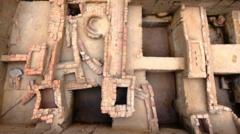Despite uncovering one of history's most significant archaeological sites, Rakhaldas Banerjee remains a largely forgotten figure in the annals of exploration. His discovery of Mohenjo-daro—a cornerstone of the Indus Valley Civilization in what is now Pakistan—marked a pivotal moment in archaeology. However, the early 20th-century explorer and epigraphist, who worked under the British colonial regime, faced numerous controversies that marred his legacy.
Banerjee, born in 1885 into a prosperous Bengali family, exhibited a passion for history from a young age, leading him to join the Archaeological Survey of India (ASI) as an excavation assistant in 1910. His pursuit of knowledge revolutionized perceptions of the ancient world, especially with his meticulous excavations at Mohenjo-daro beginning in 1919. These efforts revealed intricate urban planning and societal structures of a civilization that flourished over 5,300 years ago.
Yet, Banerjee's assertive nature often clashed with the rigid expectations of the ASI. His reports regarding Mohenjo-daro were allegedly suppressed, with claims that ASI chief John Marshall sought to claim credit for the discovery. Historians like Nayanjot Lahiri highlight Banerjee's lack of diplomacy, citing instances where he ventured to procure artifacts without approval or overspent on office equipment—tensions that ultimately led to his request for a transfer by 1924.
The legal troubles erupted further when, following a visit to a sacred site, Banerjee was implicated in the theft of a significant idol. Though exonerated, the scandal precipitated his resignation from the ASI in 1927, hampering his subsequent academic career as he struggled with financial instability and his lavish habits.
Banerjee’s untimely death at 45 left a mix of admiration and controversy in his wake. While he is somewhat of a forgotten name in the broader historical narrative, his work significantly advanced the excavation and understanding of the Indus Valley Civilization, earning him recognition among scholars and historians in Bengal. His life story serves as a reminder of the fine line between scientific advancement and personal struggles, underscoring the complexities of historical narratives that often overlook pivotal figures.
Banerjee, born in 1885 into a prosperous Bengali family, exhibited a passion for history from a young age, leading him to join the Archaeological Survey of India (ASI) as an excavation assistant in 1910. His pursuit of knowledge revolutionized perceptions of the ancient world, especially with his meticulous excavations at Mohenjo-daro beginning in 1919. These efforts revealed intricate urban planning and societal structures of a civilization that flourished over 5,300 years ago.
Yet, Banerjee's assertive nature often clashed with the rigid expectations of the ASI. His reports regarding Mohenjo-daro were allegedly suppressed, with claims that ASI chief John Marshall sought to claim credit for the discovery. Historians like Nayanjot Lahiri highlight Banerjee's lack of diplomacy, citing instances where he ventured to procure artifacts without approval or overspent on office equipment—tensions that ultimately led to his request for a transfer by 1924.
The legal troubles erupted further when, following a visit to a sacred site, Banerjee was implicated in the theft of a significant idol. Though exonerated, the scandal precipitated his resignation from the ASI in 1927, hampering his subsequent academic career as he struggled with financial instability and his lavish habits.
Banerjee’s untimely death at 45 left a mix of admiration and controversy in his wake. While he is somewhat of a forgotten name in the broader historical narrative, his work significantly advanced the excavation and understanding of the Indus Valley Civilization, earning him recognition among scholars and historians in Bengal. His life story serves as a reminder of the fine line between scientific advancement and personal struggles, underscoring the complexities of historical narratives that often overlook pivotal figures.






















